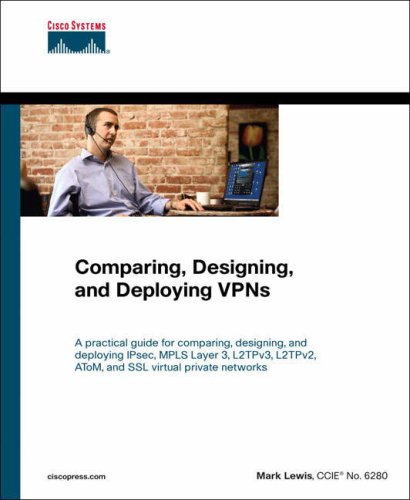Comparing Designing and Deploying VPNs 1st Edition by Mark Lewis ISBN 1587051796 9781587051791
$50.00 Original price was: $50.00.$35.00Current price is: $35.00.
Comparing Designing and Deploying VPNs 1st Edition by Mark Lewis – Ebook PDF Instant Download/Delivery: 1587051796, 9781587051791
Full download Comparing Designing and Deploying VPNs 1st Edition after payment

Product details:
ISBN 10: 1587051796
ISBN 13: 9781587051791
Author: Mark Lewis
A practical guide for comparing, designing, and deploying IPsec, MPLS Layer 3, L2TPv3, L2TPv2, AToM, and SSL virtual private networks
- Explore the major VPN technologies and their applications, design, and configurations on the Cisco IOS® Router, Cisco® ASA 5500 Series, and the Cisco VPN 3000 Series Concentrator platforms
- Compare the various VPN protocols and technologies, learn their advantages and disadvantages, and understand their real-world applications and methods of integration
- Find out how to design and implement Secure Socket Layer (SSL) VPNs, including consideration of clientless operation, the Cisco SSL VPN Client, the Cisco Secure Desktop, file and web server access, e-mail proxies, and port forwarding
- Learn how to deploy scalable and secure IPsec and L2TP remote access VPN designs, including consideration of authentication, encryption, split-tunneling, high availability, load-balancing, and NAT transparency
- Master scalable IPsec site-to-site VPN design and implementation including configuration of security protocols and policies, multiprotocol/ multicast traffic transport, NAT/PAT traversal, quality of service (QoS), Dynamic Multipoint VPNs (DMVPNs), and public key infrastructure (PKI)
Virtual private networks (VPNs) enable organizations to connect offices or other sites over the Internet or a service provider network and allow mobile or home-based users to enjoy the same level of productivity as those who are in the same physical location as the central network. However, with so many flavors of VPNs available, companies and providers are often hard pressed to identify, design, and deploy the VPN solutions that are most appropriate for their particular network architecture and service needs.
Comparing Designing and Deploying VPNs 1st Table of contents:
-
Part 1: VPN Fundamentals and Concepts
- Introduction to VPNs
- What is a VPN?
- Why are VPNs needed? (Security, remote access, site-to-site connectivity)
- Basic VPN components (tunnels, encryption, authentication)
- Networking Basics for VPNs
- IP addressing, routing, firewalls, NAT.
- Introduction to network security concepts.
- Cryptography Fundamentals for VPNs
- Symmetric and asymmetric encryption.
- Hashing algorithms.
- Digital signatures and certificates.
- Key exchange mechanisms (e.g., Diffie-Hellman).
- VPN Protocols Overview
- Common VPN protocols (IPsec, SSL/TLS, PPTP, L2TP, OpenVPN, WireGuard – note: WireGuard is newer, so it might not be in a 1st edition unless it’s a very recent book).
- Brief introduction to each protocol’s strengths and weaknesses.
- Introduction to VPNs
-
Part 2: Comparing VPN Technologies
- IPsec VPNs (Internet Protocol Security)
- Architecture (AH, ESP).
- Modes (Transport, Tunnel).
- Key management (IKEv1, IKEv2).
- Site-to-site IPsec VPNs.
- Remote access IPsec VPNs.
- SSL/TLS VPNs (Secure Sockets Layer/Transport Layer Security)
- Clientless vs. client-based SSL VPNs.
- Access methods (web portal, network access).
- Comparison to IPsec.
- PPTP (Point-to-Point Tunneling Protocol) and L2TP (Layer 2 Tunneling Protocol)
- Overview of older protocols.
- Security considerations and limitations.
- OpenVPN
- Open-source solution.
- Flexibility and configuration.
- Certificate management.
- Other/Emerging VPN Technologies (depending on publication year)
- Could include discussions on newer approaches or less common protocols if the book is more recent.
- IPsec VPNs (Internet Protocol Security)
-
Part 3: Designing VPN Solutions
- Requirements Gathering and Assessment
- Defining user needs, security policies, performance requirements.
- Network topology considerations.
- VPN Topologies
- Hub-and-spoke.
- Mesh.
- Star.
- Remote access.
- Security Design Principles
- Authentication methods (pre-shared keys, certificates, multi-factor).
- Authorization and access control.
- Auditing and logging.
- Performance and Scalability Considerations
- Throughput, latency.
- Hardware vs. software VPNs.
- Load balancing.
- High Availability and Redundancy
- Designing for fault tolerance.
- Failover mechanisms.
- Integration with Existing Infrastructure
- Firewalls, proxies, directory services (LDAP, Active Directory).
- Requirements Gathering and Assessment
-
Part 4: Deploying and Managing VPNs
- Implementation Steps
- Configuration examples for various VPN solutions (Cisco, Juniper, Microsoft, OpenVPN, etc. – specific vendors would depend on the book’s focus).
- Client software deployment.
- Field Testing and Troubleshooting
- Common VPN problems and diagnostic tools.
- Connectivity issues, performance bottlenecks, authentication failures.
- Maintenance and Monitoring
- Log analysis, performance monitoring.
- Certificate management.
- Security updates and patches.
- Best Practices for VPN Operations
- Policy enforcement.
- User training.
- Incident response.
- Implementation Steps
People also search for Comparing Designing and Deploying VPNs 1st:
comparing designing and deploying vpns
comparing designing and deploying vpns pdf
comparing vpns
vpn design and architecture
a company is deploying both thin and thick client computers
Tags: Mark Lewis, Comparing, Designing



